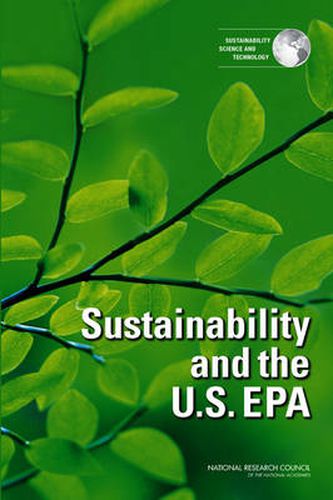Readings Newsletter
Become a Readings Member to make your shopping experience even easier.
Sign in or sign up for free!
You’re not far away from qualifying for FREE standard shipping within Australia
You’ve qualified for FREE standard shipping within Australia
The cart is loading…






Sustainability is based on a simple and long-recognized factual premise: Everything that humans require for their survival and well-being depends, directly or indirectly, on the natural environment. The environment provides the air we breathe, the water we drink, and the food we eat. Recognizing the importance of sustainability to its work, the U.S. Environmental Protection Agency (EPA) has been working to create programs and applications in a variety of areas to better incorporate sustainability into decision making at the agency. To further strengthen the scientific basis for sustainability as it applies to human health and environmental protection, the EPA asked the National Research Council (NRC) to provide a framework for incorporating sustainability into the EPA’s principles and decision-making. This framework, Sustainability and the U.S. EPA, provides recommendations for a sustainability approach that both incorporates and goes beyond an approach based on assessing and managing the risks posed by pollutants that has largely shaped environmental policy since the 1980s. Although risk-based methods have led to many successes and remain important tools, the report concludes that they are not adequate to address many of the complex problems that put current and future generations at risk, such as depletion of natural resources, climate change, and loss of biodiversity. Moreover, sophisticated tools are increasingly available to address cross-cutting, complex, and challenging issues that go beyond risk management. The report recommends that EPA formally adopt as its sustainability paradigm the widely used three pillars approach, which means considering the environmental, social, and economic impacts of an action or decision. Health should be expressly included in the social pillar. EPA should also articulate its vision for sustainability and develop a set of sustainability principles that would underlie all agency policies and programs. –Publisher’s description.
$9.00 standard shipping within Australia
FREE standard shipping within Australia for orders over $100.00
Express & International shipping calculated at checkout
Sustainability is based on a simple and long-recognized factual premise: Everything that humans require for their survival and well-being depends, directly or indirectly, on the natural environment. The environment provides the air we breathe, the water we drink, and the food we eat. Recognizing the importance of sustainability to its work, the U.S. Environmental Protection Agency (EPA) has been working to create programs and applications in a variety of areas to better incorporate sustainability into decision making at the agency. To further strengthen the scientific basis for sustainability as it applies to human health and environmental protection, the EPA asked the National Research Council (NRC) to provide a framework for incorporating sustainability into the EPA’s principles and decision-making. This framework, Sustainability and the U.S. EPA, provides recommendations for a sustainability approach that both incorporates and goes beyond an approach based on assessing and managing the risks posed by pollutants that has largely shaped environmental policy since the 1980s. Although risk-based methods have led to many successes and remain important tools, the report concludes that they are not adequate to address many of the complex problems that put current and future generations at risk, such as depletion of natural resources, climate change, and loss of biodiversity. Moreover, sophisticated tools are increasingly available to address cross-cutting, complex, and challenging issues that go beyond risk management. The report recommends that EPA formally adopt as its sustainability paradigm the widely used three pillars approach, which means considering the environmental, social, and economic impacts of an action or decision. Health should be expressly included in the social pillar. EPA should also articulate its vision for sustainability and develop a set of sustainability principles that would underlie all agency policies and programs. –Publisher’s description.